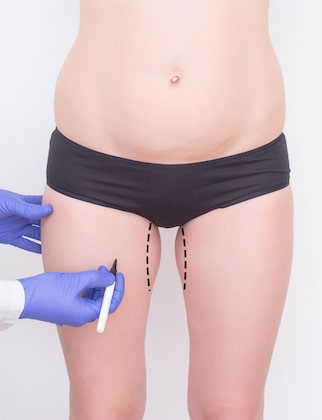
The thighs can change shape due to a variety of factors such as sagging skin as a person ages or weight loss that makes the thighs not have a smooth and shapely appearance. For patients with skin that is excess and sagging, a thigh lift might be the solution they need to improve the look of the thighs. In this article, a thigh lift procedure will be explained including what is involved in the treatment and the type of changes it can make to the thighs.
Let’s start the thigh lift lowdown with the latest video from Cosmetic Town TV:
 A thigh lift, which is also known as thighplasty, is an invasive surgical procedure that is performed to eliminate excess fat and skin from the thighs for an improved shape to the thighs. Patients might also want to have the surgery for a smoother look to the thighs and to feel more confident when wearing shorts or a swimsuit.
A thigh lift, which is also known as thighplasty, is an invasive surgical procedure that is performed to eliminate excess fat and skin from the thighs for an improved shape to the thighs. Patients might also want to have the surgery for a smoother look to the thighs and to feel more confident when wearing shorts or a swimsuit.
There are multiple thigh lift options for patients who have maintained a steady weight for at least six months. Plus, the person should already be at their intended weight goal as fluctuations in their weight can impact the results after the surgery. It is also an ideal treatment for patients who have folds of empty skin where there used to be fat on the thighs as well as people who previously had liposuction on the thighs and still have skin that is stretched.
The most common type of thigh lift is a medial/inner thigh lift. This technique addresses the issue of sagging skin in the inner thighs by creating an incision that runs from the groin area downwards to the back of the thigh area or towards the knee.
An outer thigh lift is a technique that starts with an incision that runs from the groin area and then goes outward to the hips and the lower back area. The changes made to the thighs are in the outside part of the thighs.
A mini thigh lift only requires an incision in the area of the groin and is focused on making changes to the inner part of the upper thigh.
A vertical thigh lift makes changes to excess skin that is located in all of the areas of the thighs. The incisions are larger in size, and they usually extend all the way down to the knees.
There might also be a need to combine liposuction with a thigh lift if the area of the thighs has poor skin elasticity. Liposuction can remove excess fat in the area and also prevent the further formation of sagging skin.
The procedure begins with the administering of general anesthesia so the patient will remain comfortable during the treatment. The number of incisions and their placement will be determined by the type of thigh lift being performed by the surgeon. Next, the surgeon will remove the necessary amount of fat cells and excess skin to make the desired changes. Then, sutures will be inserted into the treated area to close the incisions.
In general, the procedure should take about two hours to perform. Patients should have a friend or family member drive them home after the surgery and even stay with them the first night of the recovery period to make sure they are comfortable and settled.
The recovery process will start with the surgeon placing a dressing next to the incisions to help reduce any swelling. There might also be a need to insert drains to help remove any excess fluid and blood from the treated area.
It can take up to a year for the full results to appear, but the patient should notice an immediate improvement to their thighs. There will be some bruising, pain, and swelling after the surgery and patients will need to take time off work to properly recover. It can take several weeks to recover, and a patient will need to elevate their legs as much as possible during the recovery process. There should not be any heavy lifting or strenuous exercise for about six weeks after the surgery.
There is a possibility of some scars due to the incisions, but the surgeon will likely place the incisions in areas where they are not very noticeable.
Some of the possible risks of a thigh lift include an infection, bleeding, skin discoloration in the treated area, an accumulation of fluid, an asymmetrical look to the results, and a reduction in skin elasticity.
As long as the patient maintains a stable weight, follows the post-op instructions from their surgeon, and remains in good health, the final results are long-lasting. Thigh lift results can last for twenty years or longer if the patient follows the post-op instructions.
- MA